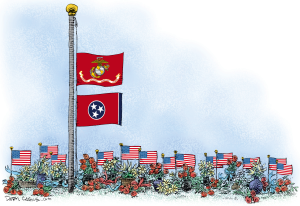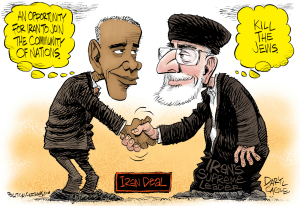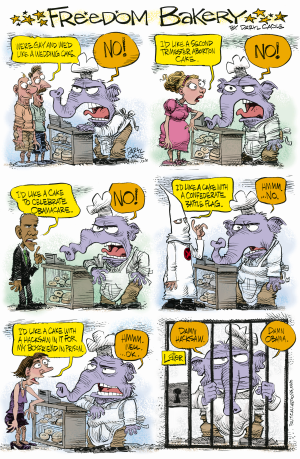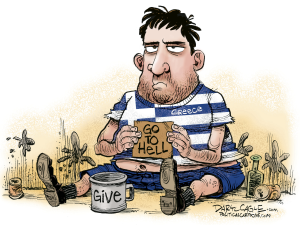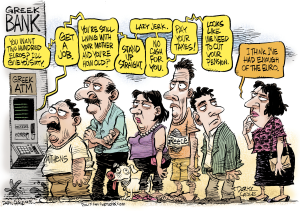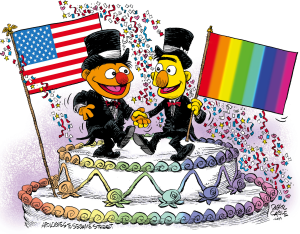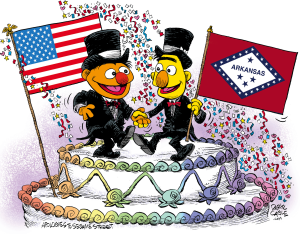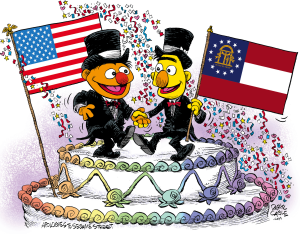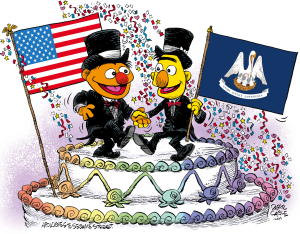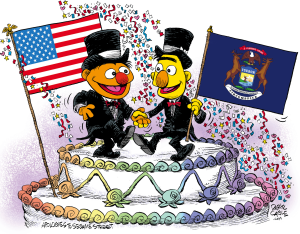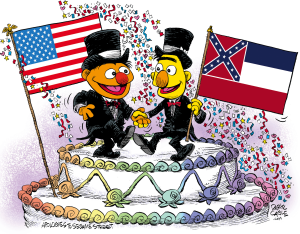
Nelson Mandela

South African political cartoonist Jeremy Nell, whose cartoons I syndicate in our Cagle Cartoons package, was fired from his job at The New Age newspaper for being too political.
“The New Age‘s editorial stance became increasingly out of sync with mine,” Nell wrote on his blog. “This was particularly apparent when the current editor recently told me that he doesn’t “like cartoons [that make] political judgements or statements.” My satire can’t really function under such constraints.”
The move has been greeted with lots of outrage from observers that suspect the paper is editorially aligned with the President Jacob Zuma and ruling African National Congress, someone Nell (and other South African cartoonists) have been harshly critical of.
One noted Zumba critic, the great South African cartoonist Zapiro, drew a cartoon today in The Times in support of Nell. Zapiro famously draws Zuma with a showerhead coming out of his head, after the African President claimed taking a shower after having unprotected sex helped cut the risk of contracting HIV.
Its nice to see professional cartooning camaraderie in such a public venue.

In South Africa, the country has been gripped by an deadly incident last week that has been dubbed the “Hill of Horror.” Police shot and killed 34 striking miners in the deadliest security incident since apartheid ended in 1994.
This story has largely gone unnoticed in the U.S., where the news has been dominated by Todd “Legitimate Rape” Akin. So I thought I’d turn to Jeremy Nell (who goes by the pen name “Jerm”), a South African cartoonist I syndicate nationally through Cagle Cartoons, to describe the event and showcase some of his cartoons.
Jerm writes:
To tell you exactly what happened is a tricky. This is why there is an official investigation ordered by the president.
In short, unionised workers at the Lonmin platinum mine, in the north west of the country, engaged in very aggressive strike action over wages. Temperatures escalated and the standoff between the miners and police ended in tragedy, with some armed miners (wielding sticks, pangas and guns) attacking the police who then fired live ammunition into the crowd. (The question of “who fired first” is being investigated.) On Thursday, 34 miners were killed (and another 10 were killed on the days leading up to it), and nearly 80 were injured. Furthermore, 2 police officers and 2 security guards were killed.
My cartoon, that followed, is really just one of disappointment in my fellow South Africans. Instead of pointing fingers, I felt it necessary to reflect on the freedoms for which Nelson Mandela fought. What happened at Lonmin is one of the bloodiest moments in South Africa’s post-apartheid history. Actually, I think it is.
Looking at the photos and footage, one would be forgiven for thinking that South Africans are still oppressed.

My second cartoon wonders about the type of language South Africans throw around. With anti-apartheid songs like “Kill The Boer”; with the president singing songs such as “Umshini Wami [bring me my machine gun]”; with politicians telling cops to “shoot to kill”; and with “kill for Zuma” rhetoric (Jacob Zuma is South Africa’s president) being vomited out of Julius Malema’s mouth, is it any wonder that many South Africans are filled with hate?
Perhaps we should look inside ourselves and think about the words we say and the songs we sing.

Speaking of former ANC Youth League president, Julius Malema, I opted for a slightly more lighthearted approach after he grabbed the opportunity to selfishly address the Lonmin miners and fire them up (as he typically does) by blaming the police (and mine bosses and Jacob Zuma and anyone else who slots into his populist strategy).
The phrase “tjatjarag” is homegrown and difficult to explain. Urban Dictionary defines it as ” To be over-eager and excitable in an annoying manner.” (which is kind of on the money).

If you want to follow more of Jerm’s South Africa cartoons, bookmark his blog.
 Readers of Cagle.com should already be aware of the cartoons of Jonathan Shapiro, who goes by the pen name “Zapiro.” He is the most famous cartoonist working in South Africa, and his hard-hitting cartoons have garnered the attention of the entire country, including its president Jacob Zuma.
Readers of Cagle.com should already be aware of the cartoons of Jonathan Shapiro, who goes by the pen name “Zapiro.” He is the most famous cartoonist working in South Africa, and his hard-hitting cartoons have garnered the attention of the entire country, including its president Jacob Zuma.
Using a tactic often employed in oppressive regimes to crack down on freedom of the press, Zuma is currently suing Zapiro for five million rand (about $640,000) over his 2008 “Rape of Lady Justice” cartoon. The lawsuit is set for trial in the South Gauteng High Court on August 28.
I sat with Zapiro while attending this year’s Cartooning for Peace event in Caen, France, and we spoke about lawsuits, freedom of the press in South Africa and the origin of the famous showerhead that Zapiro always draws on top of Zuma’s head.
[youtube http://www.youtube.com/watch?v=w3mx_wQqVPk]
Here are some of Zapiro’s famous cartoons, including the famous rape scene. To view our collection of his cartoons, click here. You can also visit his Web site here.





Zapiro on bin Laden Killing
I always find it fascinating to take a quick peek at how cartoonists across the world handle big news events. Obviously, the death of Osama bin Laden has been the biggest news story of the year, so nearly every cartoonist has their own take and spin on it.
Here are some cartoons by the great South African cartoonist Jonathan Shapiro, who goes by the pen name ‘Zapiro‘ (view more cartoons by Zapiro). You might remember his cartoon about Lady Justice getting raped by South African president Jacob Zuma. One of his trademarks is to draw Zuma with a shower head coming out of his skull, after Zuma revealed during his rape trial that he had sought to prevent himself from contracting HIV by showering after having sex with his accuser.
Zapiro’s cartoons about bin Laden’s death are interesting, viewing the events from a different perspective than an American cartoonist might. His first cartoon is the most “American,” showing bin Laden’s face as one of the twin towers:

Next, Zapiro chose to draw his own conflicted thoughts about the bin Laden mission and the larger meaning of his death:

Finally, he places bin Laden’s death in the context of the “Arab Spring” movement that is washing out dictators throughout the Middle East and Northern Africa:



